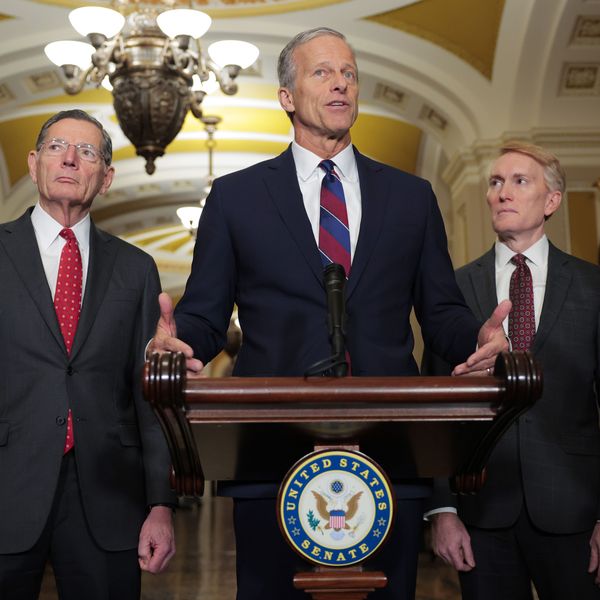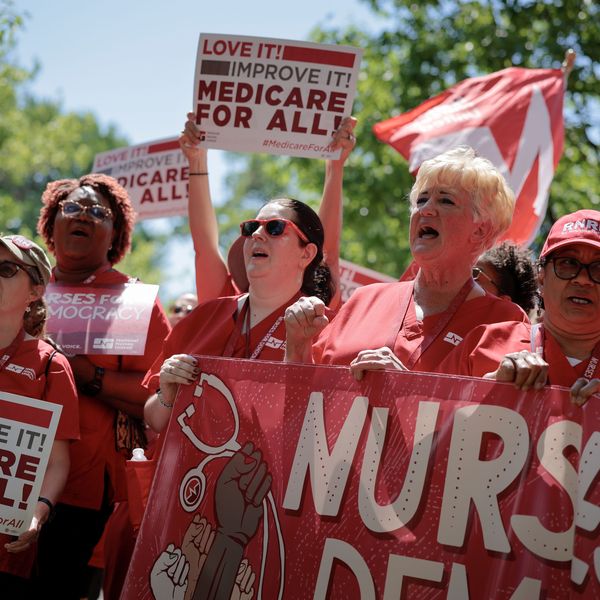Spike in Pricing, Not Baby Boomers at Heart of American Healthcare Crisis
New report debunks myth that aging population is overcrowding US healthcare, driving US cost up
Contrary to the popular notion that an aging population is driving up total U.S. healthcare costs, it is actually unrelated jumps in pricing for services and medicine that is taking a toll on America's wallets, according to a new study by the American Medical Association.
Between 2000 to 2011 alone, U.S. healthcare spending increased from $1.6 trillion to $2.7 trillion. Since 1980 costs have tripled. This "big leap," as Ben Hallman at The Huffington Post writes, owes itself "almost completely to factors other than increased demand, from the elderly or anyone else."
As the report states, "Since 2000 price, especially of hospital charges, professional services, drugs and devices, and administrative costs, not demand for services or aging of the population, produced 91% of cost increases."
"Price is the culprit," study author Hamilton Moses told reporters at a briefing in Washington. "Not population, demographics, or use and intensity that is driving the increase."
Pulling from the study, Hallman writes:
More than nine in 10 of those dollars spent, the study found, paid for higher treatment and drug costs.
Costs incurred to treat some illnesses have jumped dramatically. The U.S. government, private insurance companies and patients collectively spent $109 billion in 2010 to treat heart conditions, for example. That's up from $72 billion in 2000.
More than $40 billion was spent to treat back pain in 2010, up from 22 billion in 2000.
Hyperlipidemia care costs -- treatment for high cholesterol and triglycerides -- jumped to $38 billion in 2010 from $10 billion a decade before. That amounts to a more than 14 percent annual growth rate.
High prices for medicine and trips to the doctor, however, do not mean patients are receiving more care or higher quality care, the report argues. While the U.S. mortality rate climbs above other developed countries, less and less Americans have gained access to health care and health insurance.
"The authors have marshaled more than three decades of data to paint a bleak picture of a fractured system that is both increasingly unaffordable and under-effective," writes Hallman. "They make the case that something needs to change."
_____________________
An Urgent Message From Our Co-Founder
Dear Common Dreams reader, The U.S. is on a fast track to authoritarianism like nothing I've ever seen. Meanwhile, corporate news outlets are utterly capitulating to Trump, twisting their coverage to avoid drawing his ire while lining up to stuff cash in his pockets. That's why I believe that Common Dreams is doing the best and most consequential reporting that we've ever done. Our small but mighty team is a progressive reporting powerhouse, covering the news every day that the corporate media never will. Our mission has always been simple: To inform. To inspire. And to ignite change for the common good. Now here's the key piece that I want all our readers to understand: None of this would be possible without your financial support. That's not just some fundraising cliche. It's the absolute and literal truth. We don't accept corporate advertising and never will. We don't have a paywall because we don't think people should be blocked from critical news based on their ability to pay. Everything we do is funded by the donations of readers like you. Will you donate now to help power the nonprofit, independent reporting of Common Dreams? Thank you for being a vital member of our community. Together, we can keep independent journalism alive when it’s needed most. - Craig Brown, Co-founder |
Jacob Chamberlain is a former staff writer for Common Dreams. He is the author of Migrant Justice in the Age of Removal. His website is www.jacobpchamberlain.com.
Contrary to the popular notion that an aging population is driving up total U.S. healthcare costs, it is actually unrelated jumps in pricing for services and medicine that is taking a toll on America's wallets, according to a new study by the American Medical Association.
Between 2000 to 2011 alone, U.S. healthcare spending increased from $1.6 trillion to $2.7 trillion. Since 1980 costs have tripled. This "big leap," as Ben Hallman at The Huffington Post writes, owes itself "almost completely to factors other than increased demand, from the elderly or anyone else."
As the report states, "Since 2000 price, especially of hospital charges, professional services, drugs and devices, and administrative costs, not demand for services or aging of the population, produced 91% of cost increases."
"Price is the culprit," study author Hamilton Moses told reporters at a briefing in Washington. "Not population, demographics, or use and intensity that is driving the increase."
Pulling from the study, Hallman writes:
More than nine in 10 of those dollars spent, the study found, paid for higher treatment and drug costs.
Costs incurred to treat some illnesses have jumped dramatically. The U.S. government, private insurance companies and patients collectively spent $109 billion in 2010 to treat heart conditions, for example. That's up from $72 billion in 2000.
More than $40 billion was spent to treat back pain in 2010, up from 22 billion in 2000.
Hyperlipidemia care costs -- treatment for high cholesterol and triglycerides -- jumped to $38 billion in 2010 from $10 billion a decade before. That amounts to a more than 14 percent annual growth rate.
High prices for medicine and trips to the doctor, however, do not mean patients are receiving more care or higher quality care, the report argues. While the U.S. mortality rate climbs above other developed countries, less and less Americans have gained access to health care and health insurance.
"The authors have marshaled more than three decades of data to paint a bleak picture of a fractured system that is both increasingly unaffordable and under-effective," writes Hallman. "They make the case that something needs to change."
_____________________
Jacob Chamberlain is a former staff writer for Common Dreams. He is the author of Migrant Justice in the Age of Removal. His website is www.jacobpchamberlain.com.
Contrary to the popular notion that an aging population is driving up total U.S. healthcare costs, it is actually unrelated jumps in pricing for services and medicine that is taking a toll on America's wallets, according to a new study by the American Medical Association.
Between 2000 to 2011 alone, U.S. healthcare spending increased from $1.6 trillion to $2.7 trillion. Since 1980 costs have tripled. This "big leap," as Ben Hallman at The Huffington Post writes, owes itself "almost completely to factors other than increased demand, from the elderly or anyone else."
As the report states, "Since 2000 price, especially of hospital charges, professional services, drugs and devices, and administrative costs, not demand for services or aging of the population, produced 91% of cost increases."
"Price is the culprit," study author Hamilton Moses told reporters at a briefing in Washington. "Not population, demographics, or use and intensity that is driving the increase."
Pulling from the study, Hallman writes:
More than nine in 10 of those dollars spent, the study found, paid for higher treatment and drug costs.
Costs incurred to treat some illnesses have jumped dramatically. The U.S. government, private insurance companies and patients collectively spent $109 billion in 2010 to treat heart conditions, for example. That's up from $72 billion in 2000.
More than $40 billion was spent to treat back pain in 2010, up from 22 billion in 2000.
Hyperlipidemia care costs -- treatment for high cholesterol and triglycerides -- jumped to $38 billion in 2010 from $10 billion a decade before. That amounts to a more than 14 percent annual growth rate.
High prices for medicine and trips to the doctor, however, do not mean patients are receiving more care or higher quality care, the report argues. While the U.S. mortality rate climbs above other developed countries, less and less Americans have gained access to health care and health insurance.
"The authors have marshaled more than three decades of data to paint a bleak picture of a fractured system that is both increasingly unaffordable and under-effective," writes Hallman. "They make the case that something needs to change."
_____________________

